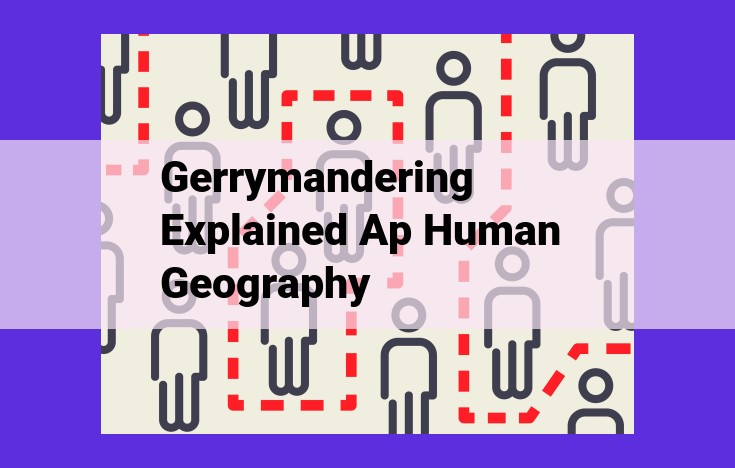Gerrymandering, the manipulation of electoral districts, aims to give an unfair advantage to a particular party or group. It takes two main forms: partisan gerrymandering favors one political party, while racial gerrymandering dilutes minority voting power. Techniques include packing (concentrating supporters in a single district) and cracking (dividing supporters across multiple districts). Gerrymandering distorts election outcomes, reduces accountability, discourages voting, and protects incumbents.
- Definition and purpose of gerrymandering
- Distinctive characteristics and controversies
Understanding Gerrymandering: A Comprehensive Guide
Gerrymandering, a politically charged term, refers to the manipulation of electoral district boundaries to favor a particular political party or group. Its purpose is to create an unfair advantage in elections by creating districts where one party has an overwhelming majority, diluting the voting power of the opposing party.
This practice often results in strangely shaped districts that resemble mythical creatures, hence the term “gerrymander.” It has been a subject of heated debate and controversy for decades, as it undermines the principle of fair representation and democratic elections.
Types of Gerrymandering: A Closer Look
Gerrymandering, the manipulation of electoral district boundaries to favor a particular political party or group, takes on two primary forms: partisan and racial gerrymandering.
Partisan Gerrymandering
Partisan gerrymandering aims to give an unfair advantage to one political party by drawing district lines that concentrate their supporters in a few districts while spreading out their opponents across many districts. This dilutes the voting power of the opposition party, making it harder for them to win elections.
For example, in North Carolina’s 2018 elections, the Republican-controlled legislature created a congressional map that resulted in Republicans winning 10 out of 13 seats, despite Democrats receiving more votes statewide. This map was later deemed unconstitutional as partisan gerrymandering.
Racial Gerrymandering
Racial gerrymandering is the creation of districts with high concentrations of minority voters to reduce their influence in other districts. This practice dilutes the voting power of minority communities, making it harder for candidates of their choice to be elected.
In Alabama, for instance, the Republican-led legislature created a congressional map that packed Black voters into one district while dispersing them across other districts. This resulted in a map that was ruled unconstitutional by the Supreme Court for violating the Voting Rights Act.
Understanding the different types of gerrymandering is crucial for addressing this insidious practice that undermines our democratic principles. By recognizing the tactics used to manipulate electoral boundaries, we can work towards fair and equitable representation for all.
Gerrymandering Techniques
When politicians redraw electoral boundaries to give their party an unfair advantage, they employ a range of techniques known as gerrymandering. Two common methods are packing and cracking.
Packing
Packing involves concentrating supporters of one party into a single district, reducing their influence in other districts. Imagine packing all the Democrats into one district, leaving the Republicans to win the remaining districts easily.
Example: The 2012 North Carolina congressional map packed African American voters into a single district, ensuring their candidate would win there but diluting their voting power in other districts.
Cracking
Cracking is the opposite of packing. Here, supporters of one party are spread across multiple districts, weakening their electoral impact. Picture splitting up Republicans into several districts, so they can’t form a majority in any of them.
Example: In Ohio, the 2011 state legislative map cracked Democratic voters among several districts, reducing their representation in the legislature.
Consequences of Gerrymandering Techniques
Both packing and cracking have profound effects on the political landscape:
- Distorted Election Outcomes: Gerrymandering can skew election results in favor of the party that controls the redistricting process, undermining the principle of fair representation.
- Reduced Voter Engagement: When voters feel their votes don’t matter due to gerrymandering, they may become discouraged from participating in the electoral process.
- Incumbency Protection: Gerrymandering benefits incumbents by creating safe districts where they face little competition, suppressing challengers and hindering political turnover.
Impacts of Gerrymandering
Gerrymandering has far-reaching consequences that can undermine the very foundations of democracy. It distorts election outcomes, discourages voter engagement, and protects incumbents at the expense of fair representation.
Political Representation
Gerrymandering manipulates district boundaries to favor one political party over another. This can result in distorted election outcomes, where the party with the most votes does not necessarily win the most seats. This undermines the principle of one person, one vote, and weakens the accountability of elected officials to their constituents.
Voter Engagement
Gerrymandering can also lead to discouragement of voting. When voters feel that their vote doesn’t matter because their district is heavily gerrymandered, they may choose not to participate in elections. This diminished efficacy undermines the public’s faith in the democratic process.
Incumbency Protection
Gerrymandering can also provide an advantage for established politicians. By drawing districts that favor incumbents, gerrymandered maps make it more difficult for challengers to win elections. This suppression of challengers can lead to stagnation in representation, as incumbents face little competition and may become disconnected from the needs of their constituents.
In conclusion, gerrymandering has severe impacts on our political system. It distorts election outcomes, discourages voter engagement, and protects incumbents. By understanding these consequences, we can work towards a more fair and representative democracy.




